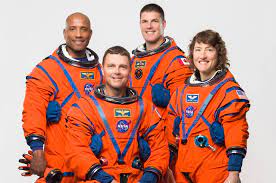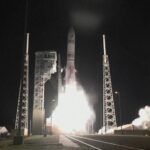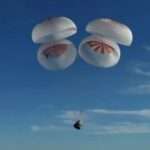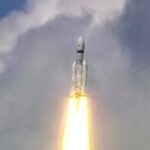
NASA has named the four astronauts who will be bridging a 50-year gap when they fly a capsule around the Moon, either late next year, or early in 2025. The crew includes the first ever woman and the very first black astronauts assigned to a lunar mission.
Christina Koch will join Victor Glover and the remaining two members of the team: Reid Wiseman and Jeremy Hansen on the assignment that is likely to take in the region of 10 days. The four of them – three from the US and one Canadian – were introduced to the public in a ceremony in Houston, Texas, where it was explained that they are now embarking on a period of intense training in readiness for the mission.
The selection of Koch and Glover backs up NASA’s commitment to bring in greater diversity. On this occasion there will not be a Moon landing, but it is hoped that it will open up a pathway for a successful touchdown in future years. The quartet will be replicating the 1968 Apollo 8 mission, which was the first ever human spaceflight to reach the Moon, and where its crew took the famous “Earthrise” picture that showed the home planet emerging from behind a lunar horizon.
The first actual Moon landing followed a year later, in 1969. The last time a manned spaceflight went to the Moon was in December 1972.
Twin missions
In 2022 the Space Agency tested its next-generation Moon rocket called the Space Launch System, and its associated crew capsule, known as Orion. The program under the name Artemis-1 went on an unmanned 25-day journey around the Moon, which gave engineers to the opportunity to assess the readiness of their hardware.
This forthcoming mission, under the name Artemis-2 has been described as “ushering in a new era of exploration for a new generation of star sailors and dreamers: the Artemis Generation,” by NASA Administrator Bill Nelson. In Greek mythology, Artemis was the twin sister of Apollo… the name of the previous missions.
System is still a work in progress
NASA’s aim is to establish a long-term presence at the Moon for science and exploration through their Artemis program. They do not actually have a system yet capable of taking astronauts physically onto the lunar surface. This is being developed by entrepreneur Elon Musk’s SpaceX company.
“Best of humanity”
The director of NASA’s Johnson Space Flight Center, the home of mission control, Vanessa Wyche said: “Among the crew are the first woman, first person of colour, and first Canadian on a lunar mission, and all four astronauts will represent the best of humanity as they explore for the benefit of all.”
First woman has plenty of space experience
For Christina Koch the mission represents her second flight into space, having served as flight engineer aboard the space station for Expedition 59, 60, and 61. Koch set a record for the longest single spaceflight by a woman with a total of 328 days in space and participated in the first all-female spacewalks.
She began her space journey with a role contributing scientific instruments to various missions, before becoming a Research Associate in the United States Antarctic Program, which included a year-long stay with a “winter-over” at the Admunsen-Scott South Pole Station and a season at Palmer Station, followed by winter seasons at Summit Station in Greenland.
Continuing to work at remote scientific bases, she served as a Field Engineer in Alaska and then as Station Chief of the American Samoa Observatory. Alongside Canadian Hansen, she will act as a supporting “mission specialist”, and at 44-years-old, she is the youngest of the crew of four.
Proud Canadian
47-year-old Jeremy Hansen is a former fighter pilot with the Royal Canadian Air Force and this will be his first space flight. He holds a Bachelor of Science in space science from the Royal Military College of Canada in Kingston, Ontario, and a Master of Science in physics from the same institution, gained in 2000, with a research focus on Wide Field of View Satellite Tracking.
The married father of three enjoys rock climbing in his spare time, and will become the first Canadian to ever venture on a lunar expedition.
Historic moment for African Americans
Victor Glover became the first African American to stay on the space station for an extended period of six months in 2021 when he was a pilot on NASA’s SpaceX Crew-1, also referred to as Resilience, where he contributed to scientific investigations, technology demonstrations, and participated in four spacewalks.
The 46-year-old Californian, who will be a pilot on The Artemis II mission, is married and has four children, He holds a Bachelor of Science in General Engineering, a Master of Science in Flight Test Engineering, a Master of Science in Systems Engineering and a Master of Military Operational Art and Science. His background is as a test pilot and naval aviator and has been deployed in combat and peacetime.
Highly capable commander
The man given the responsibility of commanding the crew is Reid Wiseman. For the 47-year-old this will be his second trip into space, serving previously as a flight engineer aboard the International Station for Expedition 41 in 2014. He has logged more than 165 days in space, including almost 13 hours as lead spacewalker during two trips outside the orbital complex.
The Maryland resident has previously spent hundreds of hours conducting valuable scientific research in areas such as human physiology, medicine, physical science, Earth science and astrophysics. He has a Bachelor of Science degree from Rensselaer Polytechnic Institute in Troy, New York, and a Master of Science in Systems Engineering from the Johns Hopkins University in Baltimore.
At their introduction ceremony in Houston, Wiseman said: “We need to celebrate this moment in human history because Artemis-II is more than a mission to the Moon and back; it is more than a mission that has to happen before we send people to the surface of the Moon; it is the next step on the journey that gets humanity to Mars.”
Next stop Mars?
Director of Flight Operations Norm Knight recognised the challenges facing the Artemis II team but was openly proud of the four of them, as in his words they: “kickstart our journeys to the Moon and beyond.” He continued to say: “They represent exactly what an astronaut corps should be, which is a mix of highly capable and accomplished individuals with the skills and determination to take on any trial as a team.”
He announced that through this mission and subsequent Artemis missions, NASA will use innovative technologies to explore more of the lunar surface than ever before and will collaborate with commercial and international partners to establish the first long-term presence on the Moon.
Adding that the Space Agency would then use what is learned on and around the Moon to then take the next giant leap, which would be the ultimate of sending the first astronauts to Mars.
Neighbours united
The plan for the mission is for the team to execute an ambitious set of demonstrations on the 10-day flight, amongst which will be the opportunity to prove the Orion spacecraft’s life-support systems, and validate the capabilities and techniques needed for humans to live and work in deep space.
Working side-by-side with NASA will be the Canadian Space Agency, who naturally are enormously proud to have representation on board. They stated that it would not only be a defining chapter of Canada’s history in space, but it would also serve as a testament to the friendship and close partnership between the two neighbouring nations.
To the far side of the moon and back
The astronauts will lift off in the Orion spacecraft from Launch Complex 39B at NASA’s Kennedy Space Center in Florida. After a two-day orbit of the Earth, a trans-lunar injection into the European-built service module, will send the crew on an outbound trip of approximately four days, taking them around the far side of the Moon, where they will ultimately create a figure of eight, extending more than 230,000 miles from Earth.
At their maximum distance, the crew will fly about 6,400 miles beyond the Moon, before embarking on their return trip using the Earth/Moon gravity field for their trajectory. It is expected to take a similar time span of four days, during which they will continue to evaluate the spacecraft’s systems.
After enduring the high-speed and high-temperature of re-entry, the team of four will splash down in the Pacific Ocean, just off the coast of San Diego, to be met no doubt by a jubilant NASA






0 Comments